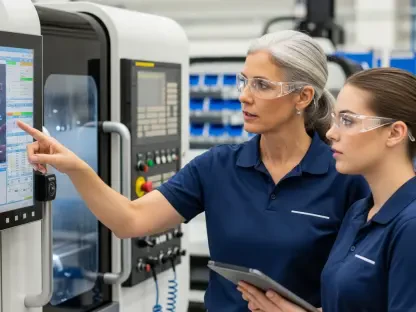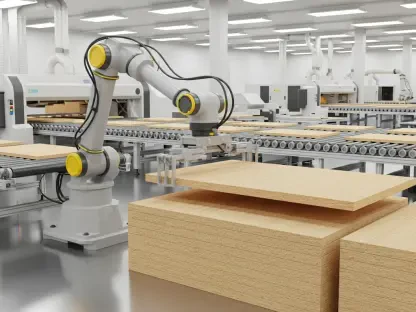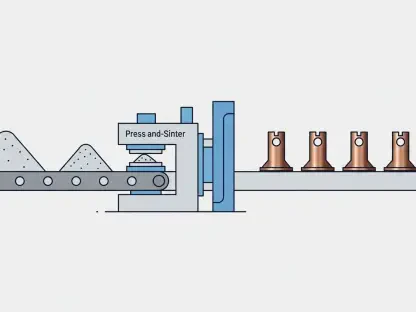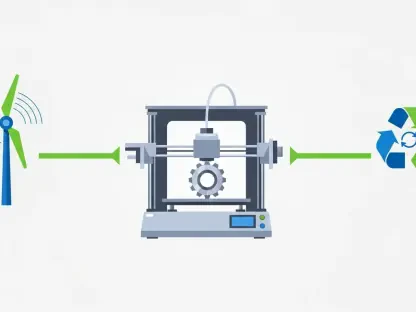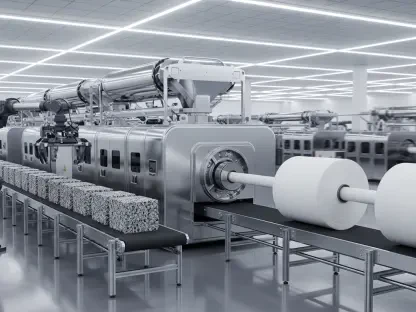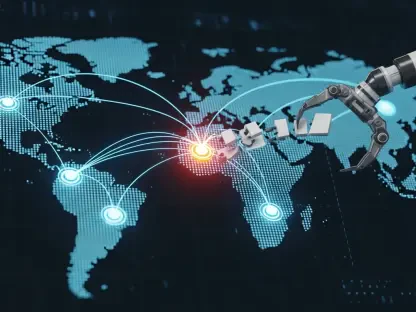The U.S. manufacturing sector stands as a cornerstone of economic vitality and national security, yet it grapples with a severe talent shortage that threatens its future. Despite a growing number of manufacturing firms across the country, job outcomes fall short of expectations, and student interest in pursuing careers in this field continues to wane. With projections estimating a demand for 3.8 million high-skill workers over the next decade, the urgency to attract, train, and retain a capable workforce has never been more critical. This pressing challenge demands innovative approaches to revitalize the talent pipeline and ensure that manufacturing remains a source of sustainable, quality employment. From outdated perceptions that paint the industry as undesirable to systemic barriers like inadequate training and inequitable pay, the obstacles are multifaceted. This exploration delves into actionable strategies that address cultural biases, economic disparities, and policy shortcomings, offering a roadmap to strengthen the sector. By fostering collaboration among stakeholders and embracing forward-thinking solutions, the industry can reclaim its position as a driver of opportunity and innovation.
Redefining Perceptions Through Early Education
Shifting the narrative around manufacturing careers begins with early intervention at the K-12 level, where outdated stereotypes often take root. Many students and their families still view the industry as a relic of the past, characterized by grueling labor in harsh conditions, rather than a modern, technology-driven field brimming with opportunity. This misconception, frequently perpetuated by parental biases and a lack of exposure, steers young talent away from considering manufacturing as a viable path. Increasing funding for outreach programs through mechanisms like the Perkins Career and Technical Education Act can play a pivotal role in changing this mindset. Such initiatives enable schools to offer tailored career coaching, hands-on experiences, and partnerships with local employers, helping students see the sector’s relevance and potential from an early age. By embedding awareness into educational curricula, the industry can begin to dismantle long-held stigmas and build a foundation of interest among the next generation.
Beyond funding, the effectiveness of outreach lies in sustained, meaningful engagement with both students and educators. Programs that bring manufacturers into classrooms or organize factory tours can provide tangible insights into the high-tech nature of today’s roles, from robotics to advanced materials. Highlighting success stories of individuals thriving in manufacturing can further inspire curiosity and ambition. Additionally, addressing the concerns of parents—often shaped by historical factory closures or economic uncertainty—requires transparent communication about job stability, growth potential, and competitive wages. These efforts must be consistent, not limited to seasonal events, to ensure that perceptions evolve alongside the industry itself. Only through such comprehensive strategies can manufacturing shed its outdated image and emerge as a respected career choice for young talent across diverse communities.
Creating Pathways Through Accessible Training
A significant barrier to entering the manufacturing workforce is the lack of accessible, affordable training options, particularly for underrepresented and low-income individuals. High tuition costs, lengthy commutes, and the absence of support services like childcare often deter potential workers from pursuing necessary education and skills development. Registered apprenticeships offer a compelling solution by integrating paid on-the-job training with classroom instruction, ensuring participants earn while they learn. This model not only alleviates financial burdens but also provides mentorship and practical experience directly aligned with employer needs. By reducing obstacles to entry, apprenticeships open doors for a broader range of candidates, fostering inclusivity and addressing the talent shortage head-on.
Equally important is the role of collaboration between educational institutions, manufacturers, and policymakers in scaling these training pathways. Community colleges and vocational schools can partner with local businesses to design programs that reflect current industry demands, ensuring relevance and applicability. Support services, such as transportation assistance or flexible scheduling, further enhance accessibility, preventing attrition among trainees facing logistical challenges. Moreover, aligning these initiatives with national workforce policies can secure funding and resources to expand their reach. The success of such programs hinges on a commitment to worker-centered design, prioritizing the needs of participants while delivering a skilled labor pool to employers. This dual focus strengthens the talent pipeline and positions manufacturing as an attainable and rewarding career for all.
Prioritizing Fair and Competitive Compensation
Manufacturing must reestablish itself as a pathway to the middle class by offering wages that outshine those in competing sectors like retail or hospitality. Currently, entry-level pay often fails to attract new workers, while mid-career and veteran employees require consistent raises to maintain the industry’s appeal as a source of stable, family-sustaining income. Beyond raw numbers, addressing historical inequities in compensation is critical to building a diverse workforce. Significant wage gaps based on race and gender persist, undermining efforts to recruit and retain talent from all backgrounds. Implementing transparent pay structures and tying public workforce funding to specific wage thresholds can drive systemic change, ensuring fairness across the board.
In addition to competitive salaries, fostering an environment of equitable treatment enhances the sector’s attractiveness. This includes clear advancement opportunities, benefits like healthcare and retirement plans, and workplace policies that address discrimination and bias. Manufacturers can differentiate themselves by showcasing a commitment to employee well-being, which not only aids retention but also builds a positive reputation among job seekers. Public campaigns during industry events can highlight these efforts, emphasizing that manufacturing offers not just jobs, but careers with long-term value. By aligning compensation with the cost of living and ensuring parity across demographics, the industry can reclaim its historical role as an economic equalizer, drawing in workers who seek both financial security and professional growth.
Advancing Growth with Targeted Trade Policies
Erratic trade policies, such as broad tariffs, have historically disrupted supply chains and hindered job growth within manufacturing, creating uncertainty for businesses and workers alike. A more effective approach lies in targeted tariffs focused on critical industries like steel and solar panels, supported by legal frameworks such as Section 301 and Section 232 of trade acts. Coupled with sustained investments like the CHIPS and Science Act, these measures can bolster domestic production and workforce development without the collateral damage of sweeping policy shifts. Strategic, long-term planning is essential to reshoring manufacturing operations and fostering an environment conducive to job creation.
Furthermore, trade policies must be complemented by international cooperation to ensure a balanced approach that protects American interests while maintaining global partnerships. Targeted investments in key sectors can stimulate innovation and create demand for skilled labor, driving employment opportunities. Policymakers should prioritize consistency, avoiding abrupt changes that erode business confidence and planning capabilities. By focusing on industries with strategic importance to national security and economic stability, such policies can lay the groundwork for sustainable growth. This deliberate focus not only strengthens manufacturing’s domestic footprint but also positions the U.S. as a leader in global markets, ensuring that jobs created are both high-quality and enduring.
Building Strength Through Collaborative Ecosystems
Industrial policies that unite companies, universities, and government entities offer a powerful mechanism to address national priorities like defense and sustainability while bolstering manufacturing employment. Initiatives such as Louisiana State University’s Future Use of Energy (FUEL) program under the National Science Foundation’s Engines Program exemplify how such collaborations can drive innovation and prepare workers for emerging fields like clean energy. These partnerships facilitate the exchange of knowledge, resources, and talent, creating a robust ecosystem that supports both industry needs and academic advancement. Despite challenges like the repeal of tax credits for advanced manufacturing, this collective approach remains vital to maintaining relevance in a competitive global economy.
The impact of these ecosystems extends beyond immediate job creation to long-term workforce development. By aligning educational curricula with industry trends, universities can produce graduates equipped for cutting-edge roles, while companies gain access to a pipeline of skilled talent. Government involvement ensures funding and policy support, addressing systemic gaps that hinder progress. Programs within these collaborations often focus on local needs, tailoring solutions to regional economic landscapes and fostering community buy-in. This localized yet interconnected strategy helps manufacturing adapt to future demands, ensuring workers are trained for roles in decarbonization and other transformative areas. Such efforts underscore the importance of synergy in revitalizing the sector and securing its place as a national asset.
Learning from Proven Success Stories
Amid the challenges facing manufacturing employment, certain programs stand as beacons of what’s possible with the right approach. The Early College Early Career (ECEC) initiative in Cleveland, led by the Manufacturing Advocacy and Growth Network, boasts a remarkable 90 percent job-offer rate for its graduates. By integrating education with paid work experience and mentorship, ECEC creates a seamless transition from learning to employment. This employer-driven model, built on partnerships between schools, community colleges, and manufacturers, offers a replicable blueprint for other regions seeking to bridge the talent gap and deliver tangible results.
The success of ECEC highlights the value of holistic talent development that prioritizes real-world application over theoretical learning alone. Students gain exposure to modern manufacturing environments, dispelling myths about the industry while acquiring in-demand skills. Meanwhile, employers benefit from a workforce tailored to their specific needs, reducing onboarding costs and time. Scaling such initiatives requires investment and commitment from all stakeholders, as well as a willingness to adapt the model to diverse local contexts. By showcasing these achievements, the industry can inspire broader adoption of innovative programs, proving that strategic collaboration can yield high-impact outcomes for both workers and businesses in the manufacturing landscape.
Tackling Deep-Rooted Systemic Barriers
While pockets of innovation offer hope, the manufacturing sector’s talent crisis is underpinned by systemic issues that demand comprehensive action. Cultural stigma continues to deter young people from considering these careers, compounded by training barriers that disproportionately affect marginalized groups. Wage disparities based on race and gender further erode trust and limit diversity within the workforce. These challenges cannot be addressed in isolation; they require a coordinated response that spans education, compensation, and policy reform to create lasting change and ensure the industry’s growth.
Beyond individual strategies, the broader ecosystem must evolve to support manufacturing’s resurgence. This includes sustained funding for education and training, policies that incentivize fair pay, and trade frameworks that prioritize domestic job creation. National events celebrating the sector can serve as platforms to highlight progress and galvanize support, but they must be paired with actionable commitments. The scale of the talent shortage—evidenced by millions of unfilled roles projected in coming years—underscores the urgency of this multifaceted approach. By confronting these entrenched barriers head-on, stakeholders can transform manufacturing into a field that not only meets economic needs but also upholds values of equity and opportunity for all.
Charting the Path Forward with Collective Action
Reflecting on the efforts to bolster manufacturing employment, it becomes clear that isolated initiatives fall short of addressing the talent crisis comprehensively. Stakeholders across education, industry, and government have tackled cultural stigmas, training gaps, and wage inequities with varying degrees of success, but the most impactful strides emerged from coordinated, systemic responses. Programs that reshaped perceptions at the K-12 level laid crucial groundwork, while accessible apprenticeships broke down barriers for diverse talent pools. Strategic trade policies and collaborative ecosystems further supported job growth in critical areas.
Looking ahead, the focus must shift to scaling these proven solutions through sustained investment and policy alignment. National campaigns should continue to celebrate manufacturing’s transformation, spotlighting career paths that offer stability and innovation. Policymakers are encouraged to prioritize long-term funding for training and education, ensuring that no potential worker is left behind due to financial or logistical hurdles. Industry leaders, in turn, should commit to equitable compensation practices as a cornerstone of talent retention. By fostering ongoing dialogue among all parties, the manufacturing sector can build on past achievements to create a resilient, inclusive workforce ready for future challenges.


